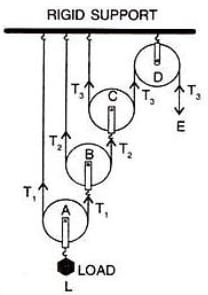Physics
Draw a diagram of combination of three movable pulleys and one fixed pulley to lift up a load. In the diagram, show the directions of load, effort and tension in each strand. Find:
(i) the mechanical advantage,
(ii) velocity ratio and
(iii) the efficiency of the combination in the ideal situation.
Machines
35 Likes
Answer
The diagram is shown below:

In equilibrium,
Effort E = T3 (1)
Tension T1 in the string passing over the pulley A is given as 2T1 = L
T1 = (2)
Tension T2 in the string passing over the pulley B is given as
2T2 = T1
T2=
Substituting value of T1 from equation 2,
T2 = (3)
Tension T3 in the string passing over the pulley C is given as
2T3 = T2
T3 =
Substituting value of T2 from equation 3,
T3 = (4)
In equilibrium, T3 = E
From equation 4,
Load L = 23 x T3 (5)
(ii) As we know, one end of each string passing over a movable pulley is fixed, so the other end of string moves up twice the distance moved by the axle of the movable pulley.
If the load L attached to the pulley A moves a distance d,
then dL = d
Now, the string connected to the axle of pulley B, moves up by a distance,
2 times d = 2d.
Then the string connected to the axle of the pulley C, moves up by a distance,
2 times 2d = 22d
Then the end of the string passing over the fixed pulley D, moves up by a distance,
2 times 22d = 23d.
Hence, dE = 23d.
As we know,
Substituting the values in the formula we get,
Answered By
17 Likes
Related Questions
State four differences between a single fixed pulley and a single movable pulley.
Draw a diagram of a block and tackle system of pulleys having a velocity ratio of 5. In your diagram indicate clearly the points of application and the directions of the load L and effort E. Also mark the tension T in each strand.
The diagram alongside shows a pulley arrangement.

(a) Name the pulleys A and B.
(b) In the diagram, mark the direction of tension on each strand of string.
(c) What is the purpose of the pulley B?
(d) If the tension is T, deduce the relation between (i) T and E, and (ii) E and L.
(e) What is the velocity ratio of the arrangement?
(f) Assuming that the efficiency of the system is 100%, what is the mechanical advantage?
The diagram alongside shows an arrangement of three pulleys A, B and C. The load is marked as L and the effort as E.

(a) Name the pulleys A, B and C.
(b) Mark in the diagram the direction of load (L), effort (E) and tension T1 and T2 in the two strings.
(c) How are the magnitudes of L and E related to the tension T1?
(d) Calculate the mechanical advantage and velocity ratio of the arrangement.
(e) What assumptions have you made in parts (c) and (d)?